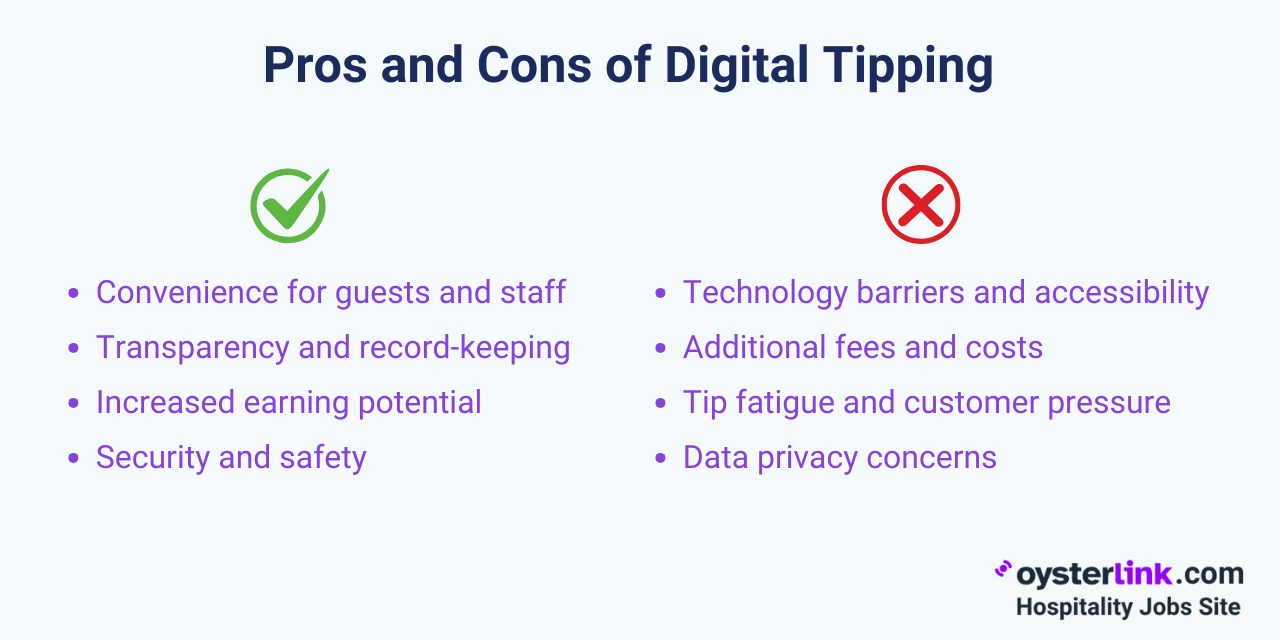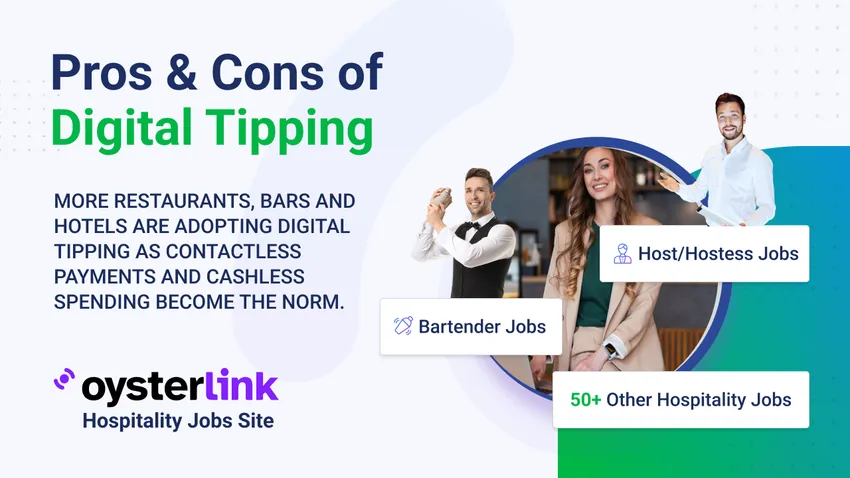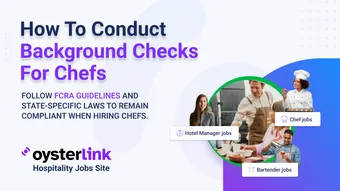As cash payments fade, tipping habits in the hospitality industry are shifting fast.
With fewer guests carrying cash, it’s becoming harder for Servers, Bartenders and Bellhops to receive traditional tips.
Digital tipping solves this problem by letting guests leave gratuities through QR codes, apps or POS prompts — quick, convenient and cash-free.
In this article, we’ll break down the key pros and cons of digital tipping.
What Is Digital Tipping?
Digital tipping refers to using electronic methods to tip hospitality workers. Popular options include
- Mobile apps
- QR codes on tables
- Links embedded in receipts
- Built-in tipping features on point-of-sale systems.
Growth of Digital Tipping Practices
More restaurants, bars and hotels are adopting digital tipping as contactless payments and cashless habits become the norm.
Today, most guests prefer paying with cards or their phones — a trend that gained momentum during the pandemic, driven by concerns about hygiene and convenience.
In fact, a recent study shows that 73% of U.S. respondents said they leave at least 11% gratuity when prompted by a digital device.
65% admitted to giving more in these scenarios compared to when they leave cash.
This highlights how digital prompts can encourage higher tips and greater generosity.
As people become increasingly comfortable with digital solutions in their daily routines, hospitality employers focus on offering these convenient options to stay competitive.
For management, keeping pace with these shifts is essential to meet the changing expectations of today’s guests.
Pros of Digital Tipping
Now that we’ve seen how digital tipping is transforming the industry, let’s explore some of the key advantages it offers for guests, staff and management alike.
Convenience for guests and staff
Digital tipping allows guests to leave a tip with just a few taps, whether by scanning a QR code or adding a tip with their order.
For staff, it means less time counting bills at closing and a lot more certainty about how much they earned that shift.
Managers also benefit from faster end-of-day reconciliations and far less friction around tip distribution — especially handy during busy weekends.
Transparency and record-keeping
With digital tipping, both staff and employers get clear, trackable records of all tips received.
This translates into easier payroll and tax reporting, plus smoother compliance for labor laws or tip pooling.
Staff who’ve spent years tracking cash tips in a notebook or spreadsheet will appreciate having digital records at tax time.
For venues already using integrated payroll/POS, digital tip data can often sync seamlessly, providing management with real-time reporting for audits or labor board inquiries.
Increased earning potential
Many digital systems include built-in tip suggestions, often prompting guests for 18%, 20% or higher.
Without the need for cash on hand, guests may tip more often or more generously — especially in places that didn’t always get cash tips, like coffee shops or self-order counters.
Managers commonly see a real boost in average tip percentage after rolling out digital tipping, though it helps to watch for guest or staff burnout from too-frequent tip prompts.
Security and safety
Switching from cash to digital tips reduces the risk of theft or lost earnings for staff.
Digital systems also limit direct staff-guest contact, which is valued in this post-pandemic world where hygiene remains on everyone’s mind.
Employers deal with less cash shrinkage, and reconciliations are smoother. Digitally tracked tips provide a stronger audit trail and reduce chances for both errors and disputes in distribution.
Cons of Digital Tipping
Understanding the potential challenges of digital tipping is essential for a balanced approach to implementation.
Here are some of the key drawbacks to keep in mind.
Technology barriers and accessibility
Not every guest is comfortable with QR codes, mobile apps or other digital payment platforms.
For instance, some older guests or international travelers may not have compatible devices or trust digital payments at all.
Staff who depend entirely on digital tips might find they’re missing out on tips from those guests.
Managers should plan to help out with some guest education, and always have a backup tip option — like a classic countertop tip jar.
It's especially important for leaders hiring positions like Bartenders to understand the challenges in the digital world.
Additional fees and costs
Digital tipping solutions, such as Square, Stripe or PayPal, usually charge transaction fees or withdrawal costs.
For staff, those fees can shave down overall tip amounts, and employers might need to pay ongoing subscription or hardware fees to keep the systems running.
Before selecting a vendor, be sure to ask for a detailed breakdown of all fees involved. It’s helpful to compare options and clearly understand how much each platform charges for transactions, monthly service or hardware.
Having this transparency enables you to manage costs effectively and communicate clearly with your team about any deductions.
Tip fatigue and customer pressure
Lots of digital devices prompt guests for tips after every interaction, even for things like just grabbing a coffee to go.
Over time, guests may feel tip fatigue. Pre-set tip levels — or the lack of a “no tip” button — can sometimes make guests feel they have no choice.
Data privacy concerns
Electronic tipping collects plenty of sensitive payment and personal data.
There’s always some concern about how that information is stored — and no one wants their tips or card data exposed in a breach. Both staff and guests will want to know their info is safe.
Hospitality leaders should ask direct questions about vendor privacy practices, and be clear about what info is being collected — especially if names, emails or phone numbers are in the mix.

Industry Impact and Future Trends
Digital tipping is rapidly reshaping tipping culture across the hospitality world.
As younger generations demand digital convenience, more businesses now integrate tipping into electronic checkouts or mobile apps.
We’ll likely see new policies, clearer disclosure of fees and maybe some legal guidance around tip distribution or data privacy.
Worker advocacy about platform fees, privacy or wage expectations will heat up, too, nudging operators and tech providers to keep evolving these systems.
Looking ahead, future trends might include tipping linked to loyalty rewards, personalized prompt options or even secure blockchain-based payment solutions for workers.
As digital tipping continues to evolve, companies that focus on balancing ease of use, transparency and fairness will lead the way for the industry.
Managers should make it a habit to revisit their tipping setup regularly — ask your staff once a year if it’s still working, and don’t hesitate to try small experiments to keep things positive.
Digital Tipping Implementation Tips for Managers
If you're ready to make the transition to digital tipping, it’s important to approach it thoughtfully.
To make the transition seamless, follow these essential steps to ensure your team and guests adapt easily and confidently:
- Evaluate vendors: Compare different digital tipping providers, considering all fees (transaction, withdrawal, support, installation) and how well their systems integrate with your POS and payroll.
- Communicate clearly: Host team meetings to introduce the new system, explaining how tips will be tracked and distributed, how fees are managed and encouraging staff to ask questions or share any concerns.
- Train staff: Prepare training materials and quick-tip sheets to help staff assist guests with digital tips, especially those unfamiliar or uncomfortable with the technology.
- Educate guests: Use signage at the POS or tables to guide guests through the digital tipping process. Remind Servers and Hosts/Hostesses to help guests struggling with QR codes, and consider still accepting cash tips as a backup.
- Monitor performance: Regularly review reports on tips, feedback and staff experiences. Be ready to make adjustments — whether refining prompts or offering alternative tipping options — if you notice issues like tip fatigue or negative feedback.
- Ensure privacy and compliance: Document your vendor’s security practices, keep your privacy policies current and review your tip reporting processes to stay compliant.
About OysterLink
OysterLink is a dedicated platform that connects restaurant teams with talented professionals.
If you're seeking your next role, OysterLink simplifies the process by offering valuable salary insights, career advice and a curated selection of top job openings.
Employers can leverage OysterLink’s suite of tools to craft attractive job ads, identify the best candidates and access resources critical to running a successful hospitality business.










Loading comments...